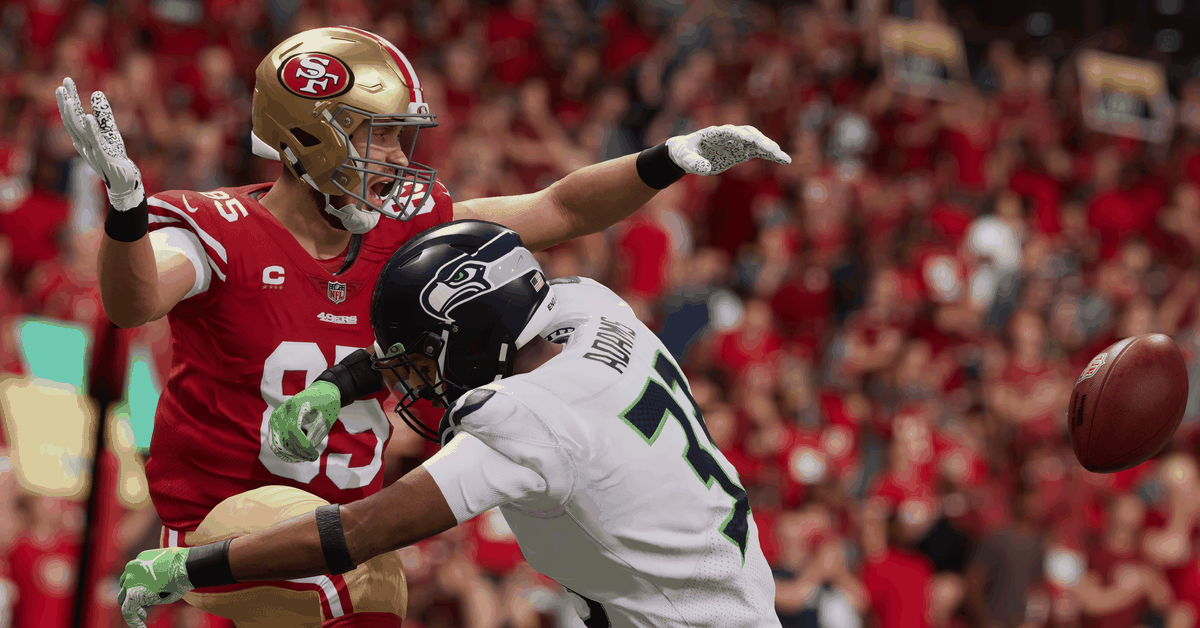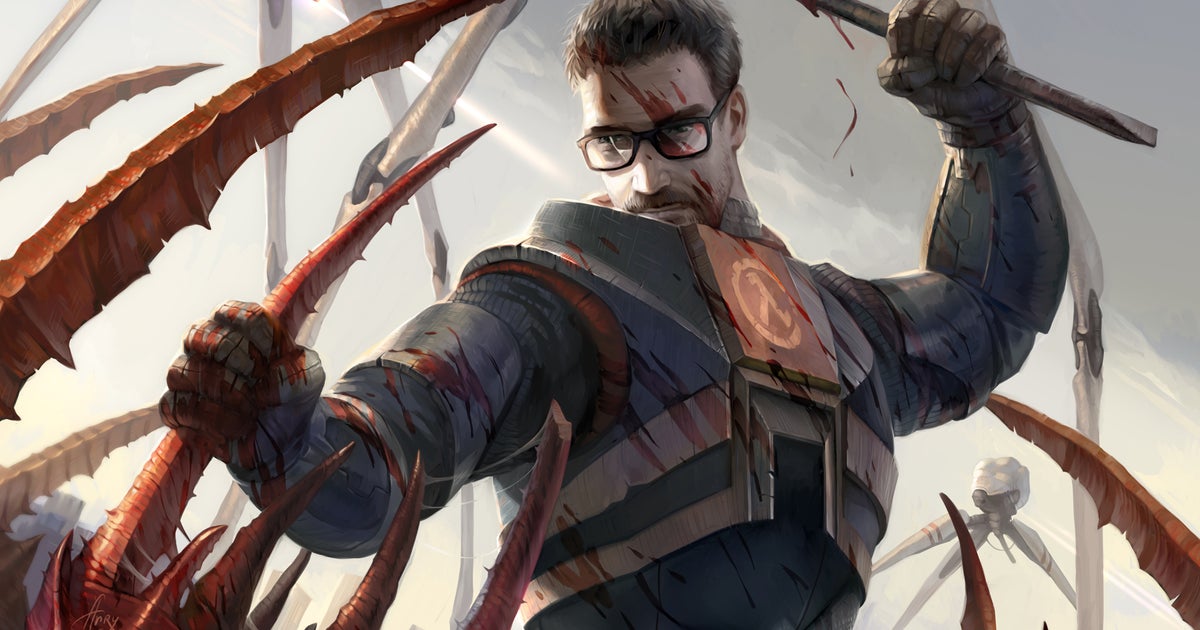The polite way of describing Face of the Franchise’s biggest problem is that Madden NFL players just wanted to get into the NFL faster in the game’s single player mode. The blunt way of putting it is that for the last three years they’ve been forced to play through a slow introduction dotted with story clichés, ridiculous dialoguesand hardly earned progress.
“There was a lot of feedback on the prologue or road to the draft, whatever you want to call it,” recalled gameplay producer Clint Oldenburg during an interview at EA Tiburon’s new studio in Orlando, Florida. “It was like, ‘I want to play in the NFL; Take me there.’ […] And that’s a big headline, “Narrative feels aimless and pointless and lacking context,” something like that. That’s what one of the reviews said.”
Whether it’s two issues or the same thing with different names, EA Tiburon will try to fix it by starting Madden NFL 23‘s Face of the Franchise mode, The League, in the fifth season of the created player’s career. No more college, no more draft, no more trembling through half a dozen games limited to Madden’s easiest difficulty only to end up being picked by the miserable New York Jets or Jacksonville Jaguars.
Face of the Franchise players start out as a free agent after their rookie contract expires, signing with any team. In my estimation it will be the first single player career mode in a sports title where a created player starts out as something other than a rookie.
“This is the first year that what’s important in this mode is being reprioritized,” Oldenburg said. In the three years since Face of the Franchise has embraced two chapters of a true narrative mode – Madden NFL 18
“What’s most important this year is the gameplay and core progression,” Oldenburg said. “We took a more modular approach this year; You’ll see far fewer longer, drawn-out scenarios that lack some context to what you’ve done in your career. What we’re going to do is get you into the weekly loop of preparing for your game, playing your game, getting your feedback and rewards from the game.”
All cinematic content follows the performance, and being modular means that these scenes respond to developments in the player’s career rather than dictating them. “Of course, the cinematic content that you and I see on our trips will be the same, but when you see it and when I see it, it will take place at different times,” he explained.
Of course, many fans are conditioned to seeing a fifth-year player as either a star or a bust, not someone who has a lot of room for growth (the whole point of this career mode, of course), but still gets his teams’ choice in the free hand. “The story we’re trying to tell is if you remember Matt Flynn [a quarterback from 2008-15] or Michael Turner [a running back, 2004-12]Guys who didn’t have much of a chance under their rookie contract, but when they played they played really well,” said Oldenburg.
:no_upscale()/cdn.vox-cdn.com/uploads/chorus_asset/file/23609461/M23_FIRSTLOOK_SCREEN_GEN5_WR_ROUTEMOVE.png)
“So now you’re a free agent, there’s a lot of talk about your potential, but you never really got the opportunity,” Oldenburg said. Created players get a new position option, Cornerback, in addition to the returning options of Linebacker, Wide Receiver, Running Back, and Quarterback. They get a one-year contract with their preferred team, which means they have to pay attention to the depth chart and offensive or defensive scheme of their choice. A New York Giants fan creating a running back might think twice about challenging Saquon Barkley unless he thinks he’s developing enough that management will give him a new five-year contract and have his competition waived or is traded.
In this way, this year-long free-agent contract works like the prologue in previous years; It just takes place in the NFL, skipping the nonsensical storylines and cameos that college offered. If the player moves to a team other than his favorite because it offers more playing time and better development, he gets a chance to sign a longer-term contract as a much better player after just one year of season.
This takes the player in a direction that Madden designers have been selling for the last few years: an avatar that is wearable across multiple game modes and positions, leveling up its attributes class by class, and gaining perk loadouts to complement them. In Face of the Franchise, Oldenburg hopes the replay experience will come from taking that avatar at a position ranked 99th overall, and then restarting that mode at a new position. While careers of 12 seasons or more are still possible in Face of the Franchise, players should be able to hit 99 after five seasons, he said.
And that’s backed up by the fact that Madden’s “99 Club” – which the game’s marketers have been touting when a true Superstar hits that number – is also made available to created players. In this case, as they reach milestones in the overall rating, they will unlock perks, cosmetics, and gameplay abilities for their character.
Oldenburg also hopes that Face of the Franchise: The League can become a showcase for many madden 23The gameplay of changes. “These gameplay mechanics were designed with Face of the Franchise in mind,” Oldenburg said. “Face of the Franchise: The League is now a true player lock mode; We removed full team control as an option.”
While the quarterback’s new passing system and ball-carriers’ new “360-degree cuts” will likely be seen most often, Oldenburg pointed to other gameplay nuances to bring to life positions that don’t see the ball as often . Wide receivers, for example, can hold both the left and right triggers and combine this with right stick movements to set more fakes, stutters and cuts at full speed when running their routes off the line. Cornerbacks will benefit from a new press-defense mechanism that Oldenburg likened to on-the-ball defense in a basketball video game.
“We’ve had that before in our game, but it was more of a rock-paper-scissors type of thing, where you chose a side on either side of the ball and saw the interaction play out depending on who got the wrong side or who chose the right side,” said Oldenburg. “These are more branching and reactionary mechanics where you can see your opponent’s movement and which way [the play] going, and you can branch off within a small window of time to take that direction away. Players press the A/X button while making their press coverage of the snap, then steer the left stick to the side of the field they want to contest.
Overall, Face of the Franchise: The League sounds like a greater commitment to the things that make single-player esports careers unique and enjoyable, and one that gets rid of components that pushed me towards a standard franchise run. Oldenburg noted that the designers were mindful that many Madden streamers and content creators are still broadcasting their Face of the Franchise careers, and the developers wanted to give them something that was as fun to watch as it was to play.
The last three FOTFs weren’t at all; They seemed to be doing everything they could to keep me from continuing, and their core experience could be essentially reproduced elsewhere with just a few menu tweaks. In other words, EA Tiburon could have just given up that disappointing crease in the single player career after three years and sent everyone back to the created Superstars of the 10-year-old Connected Franchise suite.
They didn’t. We’ll see if what they saved was worth saving when Madden NFL 23 launches August 19 on PlayStation 5 and Xbox Series X. The game will also be available on PlayStation 4, Windows PC, and Xbox One on the same day, but this mode (and other features) will not be available on those platforms.
[Disclosure: EA Sports invited Polygon and paid for its flight and accommodations at the one-day preview event at EA Tiburon’s studio.]








